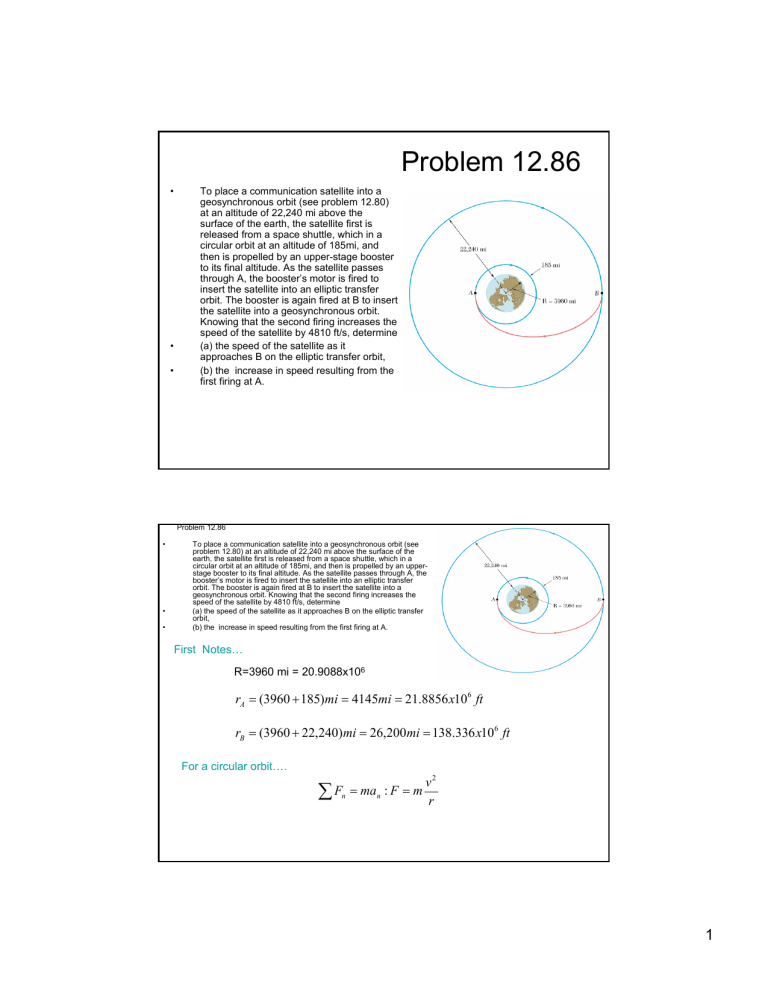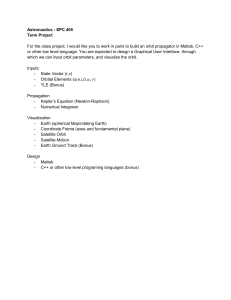
Problem 12.86 • • • To place a communication satellite into a geosynchronous orbit (see problem 12.80) at an altitude of 22,240 mi above the surface of the earth, the satellite first is released from a space shuttle, which in a circular orbit at an altitude of 185mi, and then is propelled by an upper-stage booster to its final altitude. As the satellite passes through A, the booster’s motor is fired to insert the satellite into an elliptic transfer orbit. The booster is again fired at B to insert the satellite into a geosynchronous orbit. Knowing that the second firing increases the speed of the satellite by 4810 ft/s, determine (a) the speed of the satellite as it approaches B on the elliptic transfer orbit, (b) the increase in speed resulting from the first firing at A. Problem 12.86 • • • To place a communication satellite into a geosynchronous orbit (see problem 12.80) at an altitude of 22,240 mi above the surface of the earth, the satellite first is released from a space shuttle, which in a circular orbit at an altitude of 185mi, and then is propelled by an upperstage booster to its final altitude. As the satellite passes through A, the booster’s motor is fired to insert the satellite into an elliptic transfer orbit. The booster is again fired at B to insert the satellite into a geosynchronous orbit. Knowing that the second firing increases the speed of the satellite by 4810 ft/s, determine (a) the speed of the satellite as it approaches B on the elliptic transfer orbit, (b) the increase in speed resulting from the first firing at A. First Notes… R=3960 mi = 20.9088x106 rA = (3960 + 185)mi = 4145mi = 21.8856 x106 ft rB = (3960 + 22,240)mi = 26,200mi = 138.336 x106 ft For a circular orbit…. ∑ Fn = man : F = m v2 r 1 Problem 12.86 • To place a communication satellite into a geosynchronous orbit (see problem 12.80) at an altitude of 22,240 mi above the surface of the earth, the satellite first is released from a space shuttle, which in a circular orbit at an altitude of 185mi, and then is propelled by an upperstage booster to its final altitude. As the satellite passes through A, the booster’s motor is fired to insert the satellite into an elliptic transfer orbit. The booster is again fired at B to insert the satellite into a geosynchronous orbit. Knowing that the second firing increases the speed of the satellite by 4810 ft/s, determine (a) the speed of the satellite as it approaches B on the elliptic transfer orbit, (b) the increase in speed resulting from the first firing at A. • • Newton's Law of Gravitation F =G Mm r2 Then G Mm v2 m = r2 r or v2 = Gm r Problem 12.86 • • • To place a communication satellite into a geosynchronous orbit (see problem 12.80) at an altitude of 22,240 mi above the surface of the earth, the satellite first is released from a space shuttle, which in a circular orbit at an altitude of 185mi, and then is propelled by an upperstage booster to its final altitude. As the satellite passes through A, the booster’s motor is fired to insert the satellite into an elliptic transfer orbit. The booster is again fired at B to insert the satellite into a geosynchronous orbit. Knowing that the second firing increases the speed of the satellite by 4810 ft/s, determine (a) the speed of the satellite as it approaches B on the elliptic transfer orbit, (b) the increase in speed resulting from the first firing at A. Newton's Law of Gravitation F =G Then G Mm r2 Mm v2 m = r2 r or v2 = Gm r The product of the constant of gravitation G and mass M of the earth can be expressed as: GM = gR 2 so that v2 = gR 2 r for a circular orbit 2 Problem 12.86 • • • To place a communication satellite into a geosynchronous orbit (see problem 12.80) at an altitude of 22,240 mi above the surface of the earth, the satellite first is released from a space shuttle, which in a circular orbit at an altitude of 185mi, and then is propelled by an upperstage booster to its final altitude. As the satellite passes through A, the booster’s motor is fired to insert the satellite into an elliptic transfer orbit. The booster is again fired at B to insert the satellite into a geosynchronous orbit. Knowing that the second firing increases the speed of the satellite by 4810 ft/s, determine (a) the speed of the satellite as it approaches B on the elliptic transfer orbit, (b) the increase in speed resulting from the first firing at A. (v A ) 2circ = Then: 32.2 ft x(20.9088 x106 ft ) 2 s2 21.8856 x106 ft or (v A ) circ = 25,362 2 and: (vB ) 2circ = 32.2 ft x(20.9088 x106 ft ) 2 s2 138.336 x106 ft or (vB ) circ = 10,088 2 ft s ft s Problem 12.86 • • • To place a communication satellite into a geosynchronous orbit (see problem 12.80) at an altitude of 22,240 mi above the surface of the earth, the satellite first is released from a space shuttle, which in a circular orbit at an altitude of 185mi, and then is propelled by an upper-stage booster to its final altitude. As the satellite passes through A, the booster’s motor is fired to insert the satellite into an elliptic transfer orbit. The booster is again fired at B to insert the satellite into a geosynchronous orbit. Knowing that the second firing increases the speed of the satellite by 4810 ft/s, determine (a) the speed of the satellite as it approaches B on the elliptic transfer orbit, (b) the increase in speed resulting from the first firing at A. (a) Have…. (vB ) circ = (vB )TR + ∆vB (a) or… (vB )TR = (10,088 − 4810) ft ft = 5278 s s or… (vB )TR = 5280 ft s 3 Problem 12.86 • • • To place a communication satellite into a geosynchronous orbit (see problem 12.80) at an altitude of 22,240 mi above the surface of the earth, the satellite first is released from a space shuttle, which in a circular orbit at an altitude of 185mi, and then is propelled by an upperstage booster to its final altitude. As the satellite passes through A, the booster’s motor is fired to insert the satellite into an elliptic transfer orbit. The booster is again fired at B to insert the satellite into a geosynchronous orbit. Knowing that the second firing increases the speed of the satellite by 4810 ft/s, determine (a) the speed of the satellite as it approaches B on the elliptic transfer orbit, (b) the increase in speed resulting from the first firing at A. (b) Conservation of angular momentum requires that rA m(v A )TR = rB m(vB )TR or (v A )TR = ft ft 26,200mi x5278 = 33,362 s s 4145mi Now… (v A )TR = (v A ) circ + ∆v A or… ∆v A = (33,362 − 25,362) ft s or… ∆v A = 8000 ft s 4


